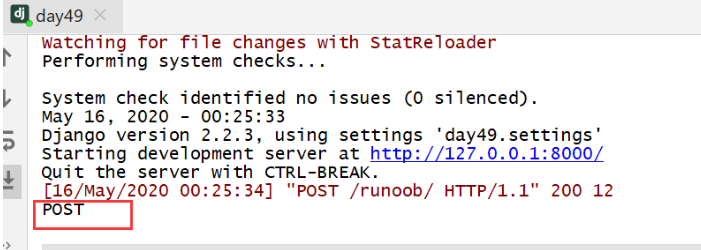标签:响应 相同 inf django time idt htm datetime query
我们将在 myapp 创建一个简单的视图显示: "welcome to yiibai !"
查看如下的视图 ?
from django.http import HttpResponse def hello(request): text = """<h1>welcome to yiibai !</h1>""" return HttpResponse(text)
查看如下的视图 ?
from django.http import HttpResponse import datetime def current_datetime(request): now = datetime.datetime.now() html = "<html><body>It is now %s.</body></html>" % now return HttpResponse(html)
以下介绍几个常用的 request 属性。
数据类型是 QueryDict,一个类似于字典的对象,包含 HTTP GET 的所有参数。
有相同的键,就把所有的值放到对应的列表里。
取值格式:对象.方法。
get():返回字符串,如果该键对应有多个值,取出该键的最后一个值。
实例
def runoob(request): name = request.GET.get("name") return HttpResponse(‘姓名:{}‘.format(name))
数据类型是 QueryDict,一个类似于字典的对象,包含 HTTP POST 的所有参数。
常用于 form 表单,form 表单里的标签 name 属性对应参数的键,value 属性对应参数的值。
取值格式: 对象.方法。
get():返回字符串,如果该键对应有多个值,取出该键的最后一个值。
实例
def runoob(request): name = request.POST.get("name") return HttpResponse(‘姓名:{}‘.format(name))
数据类型是二进制字节流,是原生请求体里的参数内容,在 HTTP 中用于 POST,因为 GET 没有请求体。
在 HTTP 中不常用,而在处理非 HTTP 形式的报文时非常有用,例如:二进制图片、XML、Json 等。
实例
def runoob(request): name = request.body print(name) return HttpResponse("教程")
获取 URL 中的路径部分,数据类型是字符串。
实例
def runoob(request): name = request.path print(name) return HttpResponse("菜鸟教程")

获取当前请求的方式,数据类型是字符串,且结果为大写。
实例
def runoob(request): name = request.method print(name) return HttpResponse("教程")

响应对象主要有三种形式:HttpResponse()、render()、redirect()。
HttpResponse(): 返回文本,参数为字符串,字符串中写文本内容。如果参数为字符串里含有 html 标签,也可以渲染。
实例
def runoob(request): # return HttpResponse("教程") return HttpResponse("<a href=‘https://www.runoob.com/‘>教程</a>")
redirect():重定向,跳转新页面。参数为字符串,字符串中填写页面路径。一般用于 form 表单提交后,跳转到新页面。
实例
render 和 redirect 是在 HttpResponse 的基础上进行了封装:
标签:响应 相同 inf django time idt htm datetime query
原文地址:https://www.cnblogs.com/BlairGrowing/p/14612848.html